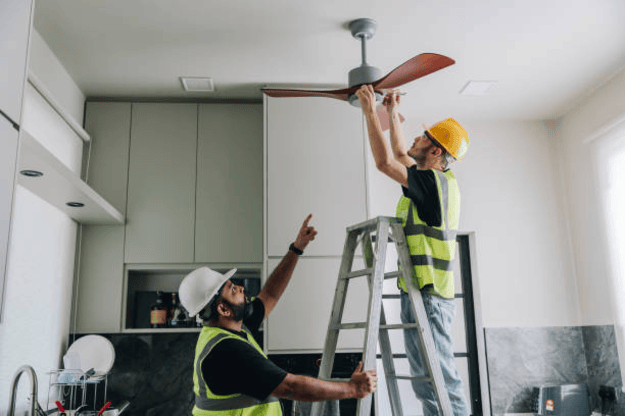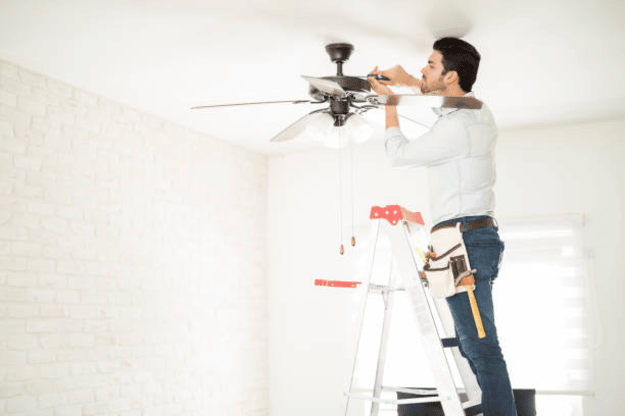Fans are indispensable to modern living, offering comfort and improved air circulation in homes, offices, and industrial settings. However, like any mechanical device, they are prone to various issues—from annoying noise and wobbling to complete operational failure.
In this comprehensive guide, we’ll explore troubleshooting common fan issues, provide practical solutions to fix them, and offer maintenance tips to extend the lifespan of your fan.
Problems Encountered with Fans

Fans have evolved significantly over the years. From traditional ceiling fans to advanced smart models, they have become more efficient and user-friendly. However, even the most modern fans can encounter problems.
Common issues include:
- Excessive noise: Unusual sounds or vibrations during operation.
- Wobbling or instability: Uneven rotation or movement.
- Lack of airflow: Reduced efficiency in circulating air.
- Electrical failures: Issues with power supply, motor malfunctions, or control settings.
- Remote control or smart feature problems: Connectivity or response issues.
Troubleshooting these problems can seem daunting, but many issues have simple, effective solutions. Whether you’re a DIY enthusiast or simply looking to understand what might be wrong with your fan, read on for expert insights and solutions.
Common Fan Problems and Their Causes
Before diving into troubleshooting, it’s essential to understand the common problems encountered by fans and their potential causes. This knowledge will help you apply the appropriate solution.
1. Excessive Noise and Vibration
Potential Causes:
- Loose Parts: Screws, blades, or mounting brackets may become loose over time.
- Worn Bearings: Bearings can degrade with continuous use, leading to increased friction.
- Dust and Debris: Accumulated dust can unbalance the fan or cause the motor to work harder.
- Improper Installation: A fan that isn’t installed correctly can vibrate excessively.
Symptoms:
- Unusual rattling, buzzing, or humming sounds.
- Noticeable vibration during operation.
- Noise that increases with speed.
2. Wobbling or Unstable Operation
Potential Causes:
- Unbalanced Blades: Damaged, bent, or unevenly weighted blades can cause imbalance.
- Improper Mounting: A loose or incorrectly installed fan may wobble.
- Structural Issues: Warped or weak mounting surfaces can affect stability.
Symptoms:
- The fan appears to move or shake.
- Visible wobbling during operation.
- Uneven airflow distribution.
3. Reduced Airflow
Potential Causes:
- Dust Accumulation: Dust on the blades or motor can reduce efficiency.
- Obstructed Air Intake/Outlet: Blockages in the fan’s path can impede air circulation.
- Motor Issues: A failing motor may not drive the blades at the intended speed.
- Speed Control Malfunctions: Issues with settings or remote controls can lead to inconsistent performance.
Symptoms:
- Lower than expected air circulation.
- Reduced cooling effect.
- Fan blades spinning slower than usual.
4. Electrical and Control Problems
Potential Causes:
- Faulty Wiring: Loose or damaged wiring can lead to intermittent operation.
- Defective Switch or Remote: Problems with the on/off switch or remote control can hinder operation.
- Power Supply Issues: Inconsistent or incorrect voltage can cause performance problems.
Symptoms:
- Fan doesn’t turn on or off as expected.
- Flickering lights on control panels.
- Unresponsive remote controls or smart features.
5. Overheating
Potential Causes:
- Blocked Ventilation: Dust and debris can obstruct airflow to the motor.
- Extended Use: Prolonged operation without breaks can lead to overheating.
- Mechanical Friction: Worn parts or poor lubrication increase friction, causing heat build-up.
Symptoms:
- Fan feels unusually warm during operation.
- Motor emits a burning smell.
- Automatic shut-off mechanisms activate.
Step-by-Step Troubleshooting and Solutions
Having identified some of the common fan problems, let’s explore effective troubleshooting steps and solutions that you can apply to fix these issues.

1. Addressing Excessive Noise and Vibration
Step 1: Inspect for Loose Parts
- Action: Turn off the fan and unplug it. Carefully inspect all screws, bolts, and brackets. Tighten any loose parts.
- Tip: Use a screwdriver or wrench to ensure everything is secure.
Step 2: Clean and Lubricate Bearings
- Action: Dust and debris can cause bearings to wear out prematurely. Use a soft brush to clean the motor and bearings. Apply a small amount of lubricant specifically designed for electric motors.
- Tip: Always use the lubricant recommended by the manufacturer.
Step 3: Balance the Blades
- Action: Check each blade for damage or warping. If a blade is bent or uneven, it may need to be replaced or straightened. For minor imbalances, adding small weights to the opposite blade can help balance the fan.
- Tip: Consider purchasing a fan balancing kit if imbalances persist.
Step 4: Check Installation
- Action: Ensure the fan is mounted on a stable, flat surface. For ceiling fans, verify that the mounting bracket is securely attached to a solid beam or support structure.
- Tip: If the fan is on a wall mount, ensure the wall is structurally sound and can support the weight of the fan.
2. Fixing Wobbling or Unstable Operation
Step 1: Examine Blade Integrity
- Action: Remove the fan blades and inspect them for any signs of damage, bending, or warping. Replace any defective blades.
- Tip: Sometimes a simple cleaning can reveal if a blade is damaged or simply covered in dust.
Step 2: Rebalance the Fan
- Action: Once you’ve inspected the blades, reattach them evenly. Use a balancing kit if necessary to ensure that the weight distribution is equal.
- Tip: Regular maintenance can prevent the onset of imbalances.
Step 3: Reassess the Mounting
- Action: Check that the fan’s mounting hardware is secure. Tighten bolts and brackets to reduce any movement.
- Tip: If the mounting surface is uneven, consider adding a mounting adapter or plate to provide a level surface.
3. Improving Reduced Airflow
Step 1: Clean the Fan Thoroughly
- Action: Dust and debris can accumulate over time, reducing airflow. Remove the fan blades and clean them with a mild detergent. Vacuum or dust the motor and air vents.
- Tip: Regular cleaning is key to maintaining optimal airflow.
Step 2: Inspect the Motor and Wiring
- Action: If cleaning doesn’t improve performance, inspect the motor for signs of wear or damage. Check all wiring connections to ensure they are secure.
- Tip: If you’re not comfortable with electrical components, consider hiring a professional electrician.
Step 3: Verify Speed Settings and Controls
- Action: Test different speed settings to see if the problem persists. If you’re using a remote control or smart feature, replace the batteries or reset the connection.
- Tip: Refer to the fan’s user manual for troubleshooting tips specific to your model.
4. Resolving Electrical and Control Issues
Step 1: Check the Power Supply
- Action: Ensure that the fan is connected to a reliable power source. If you suspect power issues, try plugging the fan into a different outlet.
- Tip: Use a voltage tester to verify the consistency of your electrical supply.
Step 2: Inspect the Switch and Remote Control
- Action: Test the fan’s manual controls. If they work but the remote doesn’t, the issue might be with the remote control. Replace batteries or reset the remote.
- Tip: Consult the manufacturer’s troubleshooting guide for resetting smart features.
Step 3: Examine the Wiring
- Action: Carefully inspect visible wiring for any signs of damage or wear. If you find frayed wires or loose connections, repair them or have a professional handle the repair.
- Tip: Always disconnect the fan from the power source before inspecting or repairing electrical components.
5. Preventing and Managing Overheating
Step 1: Improve Ventilation
- Action: Ensure that the fan’s motor has adequate ventilation. Remove any obstructions that might block airflow around the motor.
- Tip: Consider relocating the fan to a more open area if it’s in a confined space.
Step 2: Schedule Regular Breaks
- Action: If you use your fan for extended periods, allow it to rest periodically to prevent overheating.
- Tip: Many modern fans have built-in timers or automatic shut-off features to help manage continuous use.
Step 3: Maintain and Lubricate Moving Parts
- Action: Regular lubrication of moving parts can reduce friction and heat buildup. Follow the manufacturer’s recommendations for lubrication intervals.
- Tip: Use high-quality lubricants designed for electric motors.
Maintenance Tips to Prevent Future Fan Problems

Proper maintenance is the key to ensuring your fan operates efficiently and lasts longer. Here are some practical tips:
- Regular Cleaning: Dust and clean your fan at least once a month. This helps prevent the buildup of debris that can cause imbalance and reduce airflow.
- Scheduled Inspections: Check for loose screws, worn bearings, and other signs of wear regularly. Early detection can prevent minor issues from developing into major problems.
- Proper Installation: Always ensure your fan is mounted correctly and securely. Follow the manufacturer’s installation instructions and, if necessary, hire a professional.
- Lubrication: Keep moving parts well-lubricated as recommended. This reduces friction and helps maintain smooth operation.
- Battery and Remote Checks: For fans with remote controls or smart features, replace batteries periodically and update firmware if applicable.
- Environmental Considerations: Avoid placing your fan in areas with excessive dust, moisture, or temperature extremes, as these can accelerate wear and tear.
FAQs
Q1: Why is my fan making unusual noises?
A: Unusual noises are often caused by loose parts, worn bearings, or accumulated dust. Start by tightening all screws and cleaning the fan. If the noise persists, inspect the bearings and lubricate them as needed.
Q2: What causes a fan to wobble, and how can I fix it?
A: A wobbling fan is usually the result of unbalanced or damaged blades or improper installation. Check each blade for damage, ensure they are evenly attached, and use a balancing kit if necessary. Also, verify that the mounting bracket is secure.
Q3: My fan isn’t circulating air as effectively as it used to. What could be the problem?
A: Reduced airflow can be due to dust accumulation, blocked vents, or motor issues. Clean the blades and motor thoroughly, inspect for obstructions, and check the motor’s performance. Ensure that the fan’s speed settings are correctly adjusted.
Q4: How do I troubleshoot electrical problems with my fan?
A: Start by checking the power source and ensuring that the fan is plugged into a reliable outlet. Test the on/off switch and remote control. If necessary, inspect the wiring for any damage or loose connections. If you’re unsure, consult a professional electrician.
Q5: What should I do if my fan overheats?
A: Overheating may be due to blocked ventilation or extended continuous use. Ensure that the motor has adequate airflow by removing any obstructions, clean the fan to eliminate dust buildup, and allow the fan to rest periodically. Also, check for signs of mechanical friction and lubricate moving parts.
Q6: How often should I perform maintenance on my fan?
A: It is recommended to clean your fan at least once a month and inspect it for loose parts or wear it periodically. More frequent maintenance may be necessary in dusty or high-use environments.
Q7: Can regular maintenance prevent most fan problems?
A: Yes, regular maintenance—including cleaning, lubrication, and timely inspections—can significantly reduce the likelihood of encountering fan problems. It also helps extend the fan’s lifespan and ensure optimal performance.
Q8: Are there specific tools or kits available for fan maintenance?
A: Yes, there are fan balancing kits, cleaning brushes, and lubricants specifically designed for electric motors. These tools can simplify the maintenance process and help you troubleshoot common issues effectively.
Conclusion
Fan problems, while often frustrating, are typically easy to diagnose and resolve with the right approach. By understanding the common issues—ranging from excessive noise and wobbling to reduced airflow and electrical malfunctions—you can take proactive steps to troubleshoot and fix your fan. Regular maintenance, proper installation, and timely inspections not only resolve existing issues but also prevent future problems, ensuring your fan operates efficiently for years to come.
